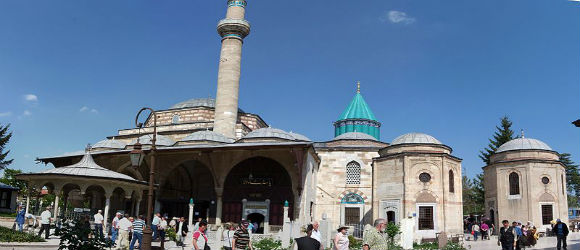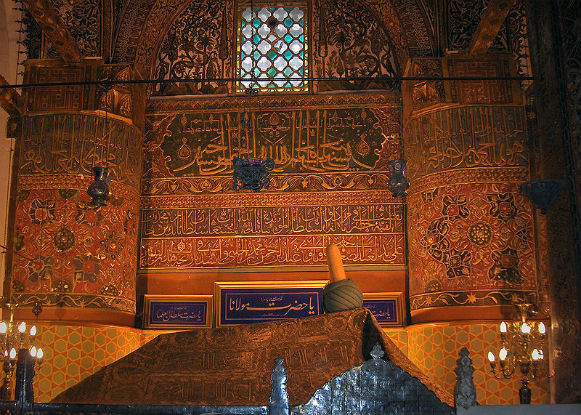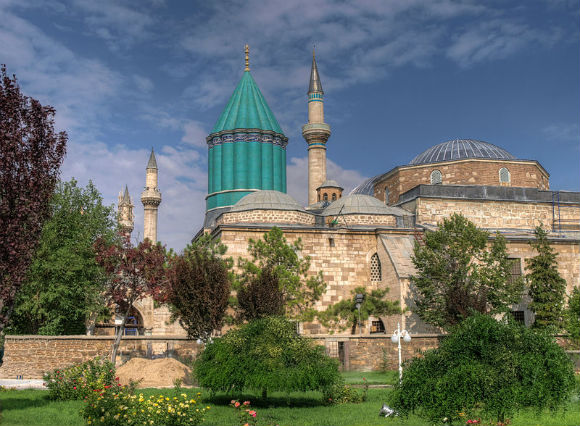The Mevlana Museum also known as the Green Mausoleum or Green Dome, is the original lodge of the Mevlevi Whirling Dervishes, a mystical Sufi Muslim group. It containes the tomb and shrine of the Mevlana, or Rumi, which remains an important place of pilgrimage.
History
Sultan ‘Ala’ al-Din Kayqubad, the Seljuk sultan who had invited Mevlana to Konya, offered his rose garden as a fitting place to bury Baha’ ud-Din Walad (or Bahaeddin Veled), the father of Mevlana, when he died in 1231. When Mevlana himself died on December 17, 1273, he was buried next to his father.
Mevlana’s successor Hüsamettin Çelebi built a mausoleum (Kubbe-i-Hadra) over the grave of his master. The Seljuk construction, under architect Behrettin Tebrizli, was finished in 1274. Gürcü Hatun, the wife of the Seljuk Emir Suleyman Pervane, and Emir Alameddin Kayser funded the construction.
The cylindrical drum of the of the dome originally rested on four pillars. The conical dome is covered with turquoise faience. Several sections were added until 1854. Selim I decorated the interior and performed the woodcarving of the catafalques.
A decree by Ataturk in September 1925 dissolved all Sufi brotherhoods in Turkey. On April 6, 1926, another decree ordered that the Mevlana mausoleum and dervish lodge be turned into a museum. The museum opened on March 2, 1927.
Special permission granted by the Turkish government in 1954 allowed the Mawlawi dervishes of Konya to perform their ritual dances for tourists for two weeks each year. Despite government opposition the order has continued to exist in Turkey as a religious body. The tomb of Rumi, although officially part of a museum, attracts a steady stream of pilgrims.
What to See
The dervish lodge (tekke) includes a semahane, where the ritual sema or whirling ceremony takes place, a sadirvan for ritual ablutions, a library, living and teaching quarters, and the mausoleum housing the tomb of Celaleddin Rumi, founder of the sect and later awarded the honorable title of Mevlana. His epitaph reads: “Do not seek our tombs on this earth – our tombs are in the hearts of the enlightened.”
The mausoleum room is highly ornamented with Islamic script and enameled reliefs, and contains the tombs of several of the more important figures of the dervish order. The main tomb enclosed behind a silver gate crafted in 1597 is that of Mevlana. The tomb of his father, Bahaeddin Veled, is upright and adjacent to his son’s, a position that signifies respect.
The adjoining room, or the semihane, is now a museum of Mevlana memorabilia displaying musical instruments and robes belonging to Mevlana, along with Selçuk and Ottoman objects like gold-engraved Korans from the 13th century. Among the fabulous ancient prayer rugs is the most valuable silk carpet in the world.
Mevlana Museum, Konya,




Unless this is your thing I would avoid it. The whole area looks nice but the exhibits were uninspiring. You walk around the building looking into some rooms and then go into the main hall where you look mainly ate various books and some clothes.
Luckily the entrance fees were reasonable.
We briefly stopped here on our way between Cappadocia and Pamukkale. This mosque is stunning with it's minarets and unique green tower. This is now a museum and inside are beautiful tiles and decorations along with the stunning mausoleum of Jalāl ad-Dīn Muhammad Rūmī. I took some illegal photos of the interior before I was forcefully told to stop. I…
"Come, come again, whoever you are, come!
Heathen, fire worshipper or idolatrous, come!
Come even if you broke your penitence a hundred times,
Ours is the portal of hope, come as you are." Mevlana
This museum is not big, but it can take a lot of space in your heart. There you can buy a sufy music. It`ll remind you…
This museum is very interesting and unfamiliar to most westerners; however, Rumi's poetry and thought is relevant for today and the museum provides intriguing insight into an important historical figure whose writings speak to us today.
When i visited in 2001 it was very open, there was no restriction for picture taking with or without flash, outside in the courtyard there were many caligraphy pictures and rooms were open.
Now you cannot take pictures with ot without flash, outside rooms are closed and you can only peep in through windows and inside some weird and very…
I went there with an organised trip from Ankara to Konya, it took around 3 hours…
it was in December 2012, the day of Mevlana celebration… the show was amazing, the music and dance… a nice sufi experience…
The Museum itself is ok, the most important is the celebration in that area… very spiritual experience…
I haven't heard about Rumi before, but had seen some of the whirling dervish dances. Had no idea that the dance was a spiritual bond between man and God.. and it was here at Mevlana Museum that I found really interesting info regarding the lives and history and the unique way of teachings of Rumi.. The Museum is a must…
We reakkyy enjoyed our visit to the mevlana museum. The exhibits are well presented and there are good explainations with them. I would highly recommend a visit
The Mausoleum was clean and well organized with the Masnavi Sharif on display. Guide were also helpful and polite.
For Muslim and non-muslims alike, the main reason to come to Konya and visit mevlana Museum is for the whriling dervishes. The mevlana has many poetry and religious writings and he is one of the respedted person in the islamic world. he said;
come, whoever you may be
even if you may be
an infedel, a pagan or a fire-worshipper,…